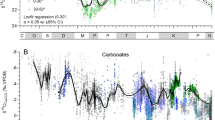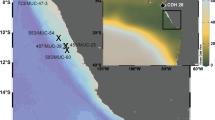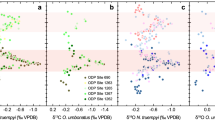Abstract
Since the first measurements were made more than thirty years ago1, analysis of oxygen isotopes in foraminifera from deep-sea sediments has gained widespread use as a palaeoclimatic and stratigraphic indicator. Isotopes stages are commonly used to define the ice ages2 but controversy still remains regarding the relative contributions of temperature and ice-volume change to the down-core δ18O record. For the past decade, temperature has commonly been considered a trivial portion of the signal3. Recent reports, however, suggest that as much as one-third of the measured δ18O variations can be ascribed to cooler glacial-maximum temperatures4,5. This interpretation requires mean deep-ocean temperatures <0 °C through much of late Quaternary time. Here we explore some of the consequences of this hypothesis for the heat budget of the deep sea, and conclude that either thermohaline overturn must have been faster than at present, or that cooling of the deep ocean at the glacial maximum may have been overestimated.
This is a preview of subscription content, access via your institution
Access options
Subscribe to this journal
Receive 51 print issues and online access
$199.00 per year
only $3.90 per issue
Buy this article
- Purchase on Springer Link
- Instant access to full article PDF
Prices may be subject to local taxes which are calculated during checkout
Similar content being viewed by others
References
Emiliani, C. J. Geol. 63, 538–578 (1955).
Shackleton, N. J. & Opdyke, N. D. Quat. Res. 3, 39–55 (1973).
Shackleton, N. J. Phil. Trans. R. Soc. B 280, 169–182 (1977).
Chappell, J. & Shackleton, N. J. Nature 324, 137–140 (1986).
Labeyrie, L. D., Duplessy, J. C. & Blanc, P. L. Nature 327, 477–482 (1987).
Epstein, S., Buchsbaum, R., Lowenstam, H. A. & Urey, H. C. Geol. Soc. Am. Bull. 64, 1315–1325 (1953).
Shackleton, N. J. Nature 215, 15–17 (1967).
Emiliani, C. in Late Cenozoic Glacial Ages (ed. Turekian, K.) 183–197 (Yale University Press, New Haven, Connecticutt, 1971).
CLIMAP Map and Chart Series MC-36 (Geol. Soc. America, Boulder, Colorado, 1981).
Imbrie, J. et al. in Milankovitch and Climate (eds Berger, A. et al.) 269–305 (Reidel, Dordrecht, 1984).
Dodge, R. E., Fairbanks, R. G., Benninger, L. K. & Maurrasse, F. Science 219, 1423–1425 (1983).
Broecker, W. S. Science 188, 1116–1118 (1975).
Johnson, R. G. & Andrew, J. T. Palaeogeogr. Palaeoclimatol. Palaeoecol. 53, 107–138 (1986).
Clark, D. L. et al. Geophys. Res. Lett. 13, 319–321 (1986).
Zahn, R., Markussen, B. & Thiede, J. Nature 314, 433–435 (1985).
Dillon, W. P. & Oldale, R. N. Geology 6, 56–60 (1978).
Veeh, H. H. & Veevers, J. J. Nature 226, 536–537 (1970).
Chappell, J. Search 14, 99–101 (1983).
Knauss, J. A. Introduction to Physial Oceanography (Prentice Hall, Englewood Cliffs, New Jersey, 1978).
Gordon, A. L. in Numerical Models of Ocean Circulation 39–53 (National Academy of Sciences, Washington, DC, 1975).
Menard, H. W. & Smith, S. M. J. geophys. Res. 71, 4305–4325 (1966).
Bryan, K. J. comput. Phys. 4, 347–376 (1969).
Broecker, W. S., Mix, A. C., Andree, A. & Oeschger, H. Nucl. Instrum. Meth. Phys. Res. 5, 331–339 (1984).
Langseth, M. & Von Herzen, R. The Sea Vol. 4, 299–345 (Wiley, New York, 1971).
Garrett, C. Dyn. Atmos. Oceans 3, 239–265 (1979).
Rind, D. & Peteet, D. Quat. Res. 24, 1–22 (1985).
Broecker, W. S. Quat. Res. 26, 121–134 (1986).
Andree, M. et al. Clim. Dyn. 1, 53–62 (1986).
Broecker, W. S. et al. (manuscript in preparation).
Mix, A. C. & Fairbanks, R. G. Earth planet. Sci. Lett. 73, 231–243 (1985).
Boyle, E. A. & Keigwin, L. D. Earth planet. Sci. Lett. 76, 135–150 (1985/86).
Broecker, W. S. in Late Cenozoic Glacial Ages (ed. Turekian, K.) 239–265 (Yale University Press, New Haven, 1971).
Boyle, E. A. & Keigwin, L. D. Nature (in the press).
Zahn, R., Sarnthein, M. & Erlenkeuser, H. Paleoceanography (in the press).
Broecker, W. S., Peteet, D. M. & Rind, D. Nature 315, 21–26 (1985).
Author information
Authors and Affiliations
Rights and permissions
About this article
Cite this article
Mix, A., Pisias, N. Oxygen isotope analyses and deep-sea temperature changes: implications for rates of oceanic mixing. Nature 331, 249–251 (1988). https://doi.org/10.1038/331249a0
Received:
Accepted:
Issue Date:
DOI: https://doi.org/10.1038/331249a0
This article is cited by
-
Ice sheets by volume
Nature (2000)
-
Analysis of the probability distribution of the late Pleistocene climatic record implications for model validation
Climate Dynamics (1990)
-
Orbital forcing in a stochastic resonance model of the Late-Pleistocene climatic variations
Climate Dynamics (1989)
-
Glacio-eustatic sea-level control on Red Sea salinity
Nature (1988)
Comments
By submitting a comment you agree to abide by our Terms and Community Guidelines. If you find something abusive or that does not comply with our terms or guidelines please flag it as inappropriate.



